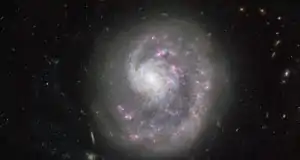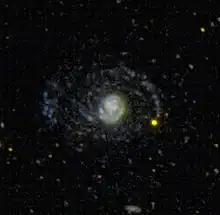| NGC 4625 | |
|---|---|
 | |
| Observation data (J2000 epoch) | |
| Constellation | Canes Venatici[1] |
| Right ascension | 12h 41m 52.7s[2] |
| Declination | +41° 16′ 26″[2] |
| Redshift | 609 ± 1 km/s[2] |
| Apparent magnitude (V) | 13.2g[2] |
| Characteristics | |
| Type | SAB(rs)m pec[2] |
| Apparent size (V) | 1.3′ × 1.2′[2] |
| Notable features | Asymmetric; Single spiral arm[3] |
| Other designations | |
| IC 3675,[2] UGC 7861,[2] PGC 42607[2] | |
NGC 4625 is a distorted dwarf galaxy in the constellation Canes Venatici. The galaxy is formally classified as a Sm galaxy, which means that its structure vaguely resembles the structure of spiral galaxies. The galaxy is sometimes referred to as a Magellanic spiral because of its resemblance to the Magellanic clouds.
Structure

Unlike most spiral galaxies, NGC 4625 has a single spiral arm, which gives the galaxy an asymmetric appearance.[3] It has been hypothesized that this galaxy's asymmetric structure may be the result of a gravitational interaction with NGC 4618.[3] Such asymmetric structure is commonly seen among many interacting galaxies. However, observations of neutral hydrogen gas in NGC 4618 and NGC 4625 show that NGC 4625 does not appear to have been affected by the gravitational interaction.[4] This indicates that the single-arm structure seen in NGC 4625 may be created through intrinsic processes.
Ultraviolet observations of NGC 4625 made by the Galaxy Evolution Explorer (GALEX) show the presence of an extended disk. The new spiral disk extrends 28,000 light-years from the galaxy center, a staggering four times the optical radius. The hot blue stars in this new disk may have formed from the inflow of fresh gas and dust from interaction with its companions, NGC 4618 and NGC 4625A.[5] The UV-to-optical colors suggest that the bulk of the stars in the disk of NGC 4625 are currently being formed, providing a unique opportunity to study today the physics of star formation under conditions similar to those when the normal disks of spiral galaxies like the Milky Way first formed.[6]
Environment
As mentioned above, NGC 4625 is interacting with NGC 4618.[3]
See also
- NGC 5713 - a similar asymmetric spiral galaxy
References
- ↑ R. W. Sinnott, ed. (1988). The Complete New General Catalogue and Index Catalogue of Nebulae and Star Clusters by J. L. E. Dreyer. Sky Publishing Corporation and Cambridge University Press. ISBN 978-0-933346-51-2.
- 1 2 3 4 5 6 7 8 9 "NASA/IPAC Extragalactic Database". Results for NGC 4625. Retrieved 2006-12-07.
- 1 2 3 4 A. Sandage; J. Bedke (1994). Carnegie Atlas of Galaxies. Washington, D.C.: Carnegie Institution of Washington. ISBN 978-0-87279-667-6.
- ↑ S. J. Bush; E. M. Wilcots (2004). "Neutral Hydrogen in the Interacting Magellanic Spirals NGC 4618 and NGC 4625". Astrophysical Journal. 128 (6): 2789–2796. arXiv:astro-ph/0409209. Bibcode:2004AJ....128.2789B. doi:10.1086/425876. S2CID 14636586.
- ↑ Martin Ratcliffe (December 8, 2006). State of the Universe 2007: New Images, Discoveries, and Events. Google Books: Springer Praxis Books. p. 29. ISBN 978-0387341781.
- ↑ A. Gil de Paz; et al. (9 June 2005). "Discovery of an Extended Ultraviolet Disk in the Nearby Galaxy NGC 4625". The Astrophysical Journal Letters. 625 (1): 29–32. arXiv:astro-ph/0506357. Bibcode:2005ApJ...627L..29G. doi:10.1086/432054. S2CID 55384358.
External links
 Media related to NGC 4625 at Wikimedia Commons
Media related to NGC 4625 at Wikimedia Commons